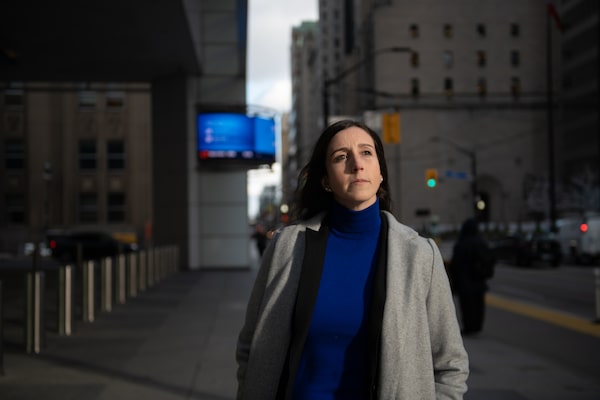
There is a growing pressure on companies to provide consistent and comparable information on their financially material ESG risks and opportunities, says Sarah Keyes, CEO of ESG Global Advisors.GALIT RODAN/THE GLOBE AND MAIL
Interest in integrating environmental, social and governance (ESG) factors into investment decision-making has been skyrocketing, driven by growing concerns over climate change and social issues. But as investors are increasingly focusing on companies’ ESG outcomes, they’re also looking to engage with businesses that still have progress to make.
Although ESG investment assets grew in most regions in the two years to early 2020, Canada’s 48-per-cent increase was the largest in absolute terms, according to data from the Global Sustainable Investment Alliance. Across the global investment industry, Canada also now has the highest proportion of sustainable investment assets relative to total assets, at 62 per cent or nearly $3.2-trillion.
On the retail side, net asset flows into Canada-domiciled responsible investment mutual funds and exchange-traded funds (ETFs) reached $7.5-billion in the first half of 2021, compared with $3.3-billion in all of 2020, according to Morningstar data.
Along with this increase in investment is a growing pressure on companies to provide consistent and comparable information on their financially material ESG risks and opportunities, explains Sarah Keyes, chief executive officer of ESG Global Advisors in Toronto.
“Investors want to understand how companies are identifying, assessing and managing ESG and particularly, climate change risks and opportunities,” she says. “They’ve been thinking about ESG and integrating it into their investment process for longer, so they’re really driving the frameworks that companies are using.”
In late 2020, for example, Canada’s largest eight institutional investors, including Caisse de dépôt et placement du Québec, CPP Investments (Canadian Pension Plan Investment Board), HOOPP (Healthcare of Ontario Pension Plan), OMERS (Ontario Municipal Employees Retirement System), and the Ontario Teachers’ Pension Plan, issued a joint statement calling on companies and investors to provide consistent and complete ESG information to strengthen investment decision-making and better assess and manage their collective ESG risk exposures.
The signatories, which represent about $1.6-trillion in assets, called on companies to voluntarily adopt two key reporting frameworks so that investors could consistently compare companies’ ESG disclosures within a given sector — the Sustainability Accounting Standards Board (SASB) standards and the Task Force on Climate-Related Financial Disclosures (TCFD) framework.
Companies are responding, Ms. Keyes says, with many demonstrating a desire to meet the information needs of investors. However, challenges remain when it comes to collecting the data and the information that investors seek, given the different reporting frameworks in place.
Recent developments, such as the Canadian Securities Administrators proposed mandatory climate-related disclosure requirements for public companies, may ultimately help close the gap. In the current environment, those who have not proactively disclosed their position on their material ESG risks and opportunities may face a potential loss of access to or higher cost of capital, says Ms. Keyes.
At the same time, says Dustyn Lanz, CEO of the Responsible Investment Association (RIA), while there is still a lot of discussion around selling these investments or choosing not to hold these companies, the investment community is also playing a bigger role in engaging companies, especially on climate action.
This year for example, RIA helped to co-ordinate Climate Engagement Canada, which brought together 27 institutional investors collectively managing over $3-trillion in assets. The initiative aims to work collaboratively to drive Canada’s business transition to net-zero by engaging with 40 of Canada’s highest emitting companies to encourage the best practices around climate change disclosures, risks and opportunities.
In other cases, collaborative engagement, he adds, has taken the form of encouraging structural change from within, for example, by adding climate-conscious directors to boards.
More broadly, says Mr. Lanz, institutional investors want to see companies disclose useful information about how they are managing their exposure to ESG risks and opportunities, including climate change and diversity, and are looking for specific targets and significant progress.
“The big questions are: is the company setting meaningful goals in these areas? Are they developing plans — credible plans — to achieve those goals? Are they being transparent about their goals and their plans? What’s the governance structure around these issues? Does the board have oversight? Does the board have the expertise to oversee these issues?” he says.
Engagement strategies are a positive approach toward making progress on the underlying issues, says Joss Biggins, investment advisor with EthicInvest, a division of Leede Jones Gable Inc. in Vancouver. While he is looking forward to the structural change and improved metrics being driven by large asset managers, he notes, they are also reacting to retail demand.
“The people are going to push the institutions in a certain direction and change that structurally,” he says. “The large institutional money needs to see that there’s risk that was currently not priced in and there [are] opportunities that were currently unseen. And we now need to integrate those into our investment practices. So, they see that,” he adds.
On the individual investor side, while the current data is pointing them in the right direction, his clients know there is still work to be done to standardize ESG metrics. At the moment, Mr. Biggins says clients are increasingly concerned with social issues and carbon intensity — and they want to see companies finding solutions to issues, rather than just an ESG score.
Indeed, with responsible investment growing so rapidly in Canada, Mr. Lanz expects the focus to continue to shift towards more collaborative engagement, interest in social issues to continue to grow, and ESG outcomes to become a priority for reporting and disclosures, such as what are the specific ESG strategies being used and how do they stack up against each other? How is the industry driving results?
" ‘Do my investments reduce emissions? Did my money contribute to improved diversity or human rights protections? Did my mutual fund help get more climate-conscious directors on a company’s board?’ I think investors want answers to these questions,” he says.